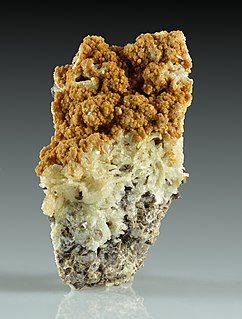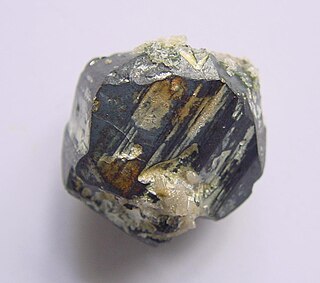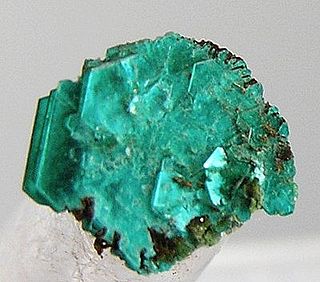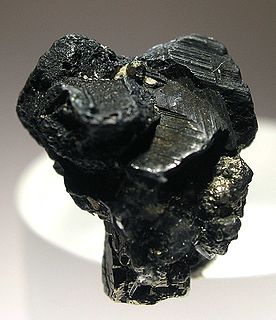
The pyroxenes are a group of important rock-forming inosilicate minerals found in many igneous and metamorphic rocks. Pyroxenes have the general formula XY(Si,Al)2O6, where X represents calcium (Ca), sodium (Na), iron or magnesium (Mg) and more rarely zinc, manganese or lithium, and Y represents ions of smaller size, such as chromium (Cr), aluminium (Al), magnesium (Mg), cobalt (Co), manganese (Mn), scandium (Sc), titanium (Ti), vanadium (V) or even iron or. Although aluminium substitutes extensively for silicon in silicates such as feldspars and amphiboles, the substitution occurs only to a limited extent in most pyroxenes. They share a common structure consisting of single chains of silica tetrahedra. Pyroxenes that crystallize in the monoclinic system are known as clinopyroxenes and those that crystallize in the orthorhombic system are known as orthopyroxenes.

Baddeleyite is a rare zirconium oxide mineral (ZrO2 or zirconia), occurring in a variety of monoclinic prismatic crystal forms. It is transparent to translucent, has high indices of refraction, and ranges from colorless to yellow, green, and dark brown. See etymology below.

Allanite (also called orthite) is a sorosilicate group of minerals within the broader epidote group that contain a significant amount of rare-earth elements. The IMA symbol is Aln. The mineral occurs mainly in metamorphosed clay-rich sediments and felsic igneous rocks. It has the general formula A2M3Si3O12[OH], where the A sites can contain large cations such as Ca2+, Sr2+, and rare-earth elements, and the M sites admit Al3+, Fe3+, Mn3+, Fe2+, or Mg2+ among others. However, a large amount of additional elements, including Th, U, Be, Zr, P, Ba, Cr and others may be present in the mineral. The International Mineralogical Association lists four minerals in the allanite group, each recognized as a unique mineral: allanite-(Ce), allanite-(La), allanite-(Nd), and allanite-(Y), depending on the dominant rare earth present: cerium, lanthanum, neodymium or yttrium.

Zanazziite is a complex hydrated phosphate mineral from the roscherite group. It is a magnesium beryllium phosphate mineral. Zanazziite arises as barrel-shaped crystals and can reach up to 4 mm. It grows alongside quartz minerals. It is found in the crevices of Lavra da Ilha pegmatite, near Taquaral, in northeastern Minas Gerais, Brazil. Zanazziite is named after Pier F. Zanazzi. Zanazziite has an ideal chemical formula of Ca2Mg5Be4(PO4)6(OH)4·6H2O.

Digenite is a copper sulfide mineral with formula: Cu9S5. Digenite is a black to dark blue opaque mineral that crystallizes with a trigonal - hexagonal scalenohedral structure. In habit it is usually massive, but does often show pseudo-cubic forms. It has poor to indistinct cleavage and a brittle fracture. It has a Mohs hardness of 2.5 to 3 and a specific gravity of 5.6. It is found in copper sulfide deposits of both primary and supergene occurrences. It is typically associated with and often intergrown with chalcocite, covellite, djurleite, bornite, chalcopyrite and pyrite. The type locality is Sangerhausen, Thuringia, Germany, in copper slate deposits.

Djurleite is a copper sulfide mineral of secondary origin with formula Cu31S16 that crystallizes with monoclinic-prismatic symmetry. It is typically massive in form, but does at times develop thin tabular to prismatic crystals. It occurs with other supergene minerals such as chalcocite, covellite and digenite in the enriched zone of copper orebodies. It is a member of the chalcocite group, and very similar to chalcocite, Cu2S, in its composition and properties, but the two minerals can be distinguished from each other by x-ray powder diffraction. Intergrowths and transformations between djurleite, digenite and chalcocite are common. Many of the reported associations of digenite and djurleite, however, identified by powder diffraction, could be anilite and djurleite, as anilite transforms to digenite during grinding.

Wadsleyite, a high-pressure phase of olivine, is an orthorhombic mineral with the formula β-(Mg,Fe)2SiO4. It was first found in nature in the Peace River meteorite from Alberta, Canada. It is formed by a phase transformation from olivine (α-(Mg,Fe)2SiO4) under increasing pressure and eventually transforms into spinel-structured ringwoodite (γ-(Mg,Fe)2SiO4) as pressure increases further. The structure can take up a limited amount of other bivalent cations instead of magnesium, but contrary to the α and γ structures, a β structure with the sum formula Fe2SiO4 is not thermodynamically stable. Its cell parameters are approximately a = 5.7 Å, b = 11.71 Å and c = 8.24 Å.

Chalcophyllite is a rare secondary copper arsenate mineral occurring in the oxidized zones of some arsenic-bearing copper deposits. It was first described from material collected in Germany. At one time chalcophyllite from Wheal Tamar in Cornwall, England, was called tamarite, but this name is now discredited. At Wheal Gorland a specimen exhibiting partial replacement of liriconite, Cu
2Al(AsO
4)(OH)
4•(4H
2O), by chalcophyllite has been found. The mineral is named from the Greek, chalco "copper" and fyllon, "leaf", in allusion to its composition and platy structure. It is a classic Cornish mineral that can be confused with tabular spangolite.
Eudialyte group is a group of complex trigonal zircono- and, more rarely, titanosilicate minerals with general formula [N(1)N(2)N(3)N(4)N(5)]3[M(1a)M(1b)]3M(2)3M(4)Z3[Si24O72]O'4X2, where N(1) and N(2) and N(3) and N(5) = Na+ and more rarely H3O+ or H2O, N(4) = Na+, Sr2+, Mn2+ and more rarely H3O+ or H2O or K+ or Ca2+ or REE3+ (rare earth elements), M(1) and M(1b) = Ca2+, M(1a) = Ca2+ or Mn2+ or Fe2+, M(2) = Fe (both II and III), Mn and rarely Na+, K+ or Zr4+, M(3) = Si, Nb and rarely W, Ti and [] (vacancy), M(4) = Si and or rarely [], Z Zr4+ and or rarely Ti4+, and X = OH−, Cl− and more rarely CO32− or F−. Some of the eudialyte-like structures can even be more complex, however, in general, its typical feature is the presence of [Si3O9]6− and [Si9O27]18− ring silicate groups. Space group is usually R3m or R-3m but may be reduced to R3 due to cation ordering. Like other zirconosilicates, the eudialyte group minerals possess alkaline ion-exchange properties, as microporous materials.

Dollaseite-(Ce) is a sorosilicate end-member epidote rare-earth mineral which was discovered by Per Geijer (1927) in the Ostanmossa mine, Norberg district, Sweden. Dollaseite-(Ce), although not very well known, is part of a broad epidote group of minerals which are primarily silicates, the most abundant type of minerals on earth. Dollaseite-(Ce) forms as dark-brown subhedral crystals primarily in Swedish mines. With the ideal chemical formula, CaREE3+
Mg
2AlSi
3O
11,(OH)F, dollaseite-(Ce) can be partially identified by its content of the rare earth element cerium.
Changbaiite (PbNb2O6) is a member of the oxide mineral class in which the mineral contains oxygen which is grouped along with one or two metal ion. Changbaiite is classified as a multiple Oxide XY2O6 and it generally has an ionic bond. Furthermore, it is also orthorhombic at a temperature of 25 °C and it changes to orthorhombic-tetragonal at 570 °C.
Cleusonite is a member of the crichtonite group of minerals with the chemical formula (Pb,Sr)(U4+
,U6+
)(Fe2+
,Zn)
2(Ti,Fe2+
,Fe3+
)
18(O,OH)
38. This group of minerals contains approximately thirteen complex metal titanates. The structures of minerals of this group is complicated by frequent fine-scale twinning and metamictization due to radioactive elements. The crichtonite group consists of members of related mineral species of the type A{BC2D6E12}O38 which are characterized by their predominant cations (as seen in crichtonite (Sr), senaite (Pb), davidite (REE + U), landauite (Na), loveringite (Ca), lindsleyite (Ba), and mathiasite (K).

Tuperssuatsiaite is a rare clay mineral found in Greenland, Namibia and Brazil. It is a hydrated phyllosilicate of sodium and iron.

Pearceite is one of the four so-called "ruby silvers", pearceite Cu(Ag,Cu)6Ag9As2S11, pyrargyrite Ag3SbS3, proustite Ag3AsS3 and miargyrite AgSbS2. It was discovered in 1896 and named after Dr Richard Pearce (1837–1927), a Cornish–American chemist and metallurgist from Denver, Colorado.

Köttigite is a rare hydrated zinc arsenate which was discovered in 1849 and named by James Dwight Dana in 1850 in honour of Otto Friedrich Köttig (1824–1892), a German chemist from Schneeberg, Saxony, who made the first chemical analysis of the mineral. It has the formula Zn3(AsO4)2·8H2O and it is a dimorph of metaköttigite, which means that the two minerals have the same formula, but a different structure: köttigite is monoclinic and metaköttigite is triclinic. There are several minerals with similar formulae but with other cations in place of the zinc. Iron forms parasymplesite Fe2+3(AsO4)2·8H2O; cobalt forms the distinctively coloured pinkish purple mineral erythrite Co3(AsO4)2·8H2O and nickel forms annabergite Ni3(AsO4)2·8H2O. Köttigite forms series with all three of these minerals and they are all members of the vivianite group.

Carminite (PbFe3+2(AsO4)2(OH)2) is an anhydrous arsenate mineral containing hydroxyl. It is a rare secondary mineral that is structurally related to palermoite (Li2SrAl4(PO4)4(OH)4). Sewardite (CaFe3+2(AsO4)2(OH)2) is an analogue of carminite, with calcium in sewardite in place of the lead in carminite. Mawbyite is a dimorph (same formula, different structure) of carminite; mawbyite is monoclinic and carminite is orthorhombic. It has a molar mass of 639.87 g. It was discovered in 1850 and named for the characteristic carmine colour.
The mineral khmaralite is a beryllium bearing mineral of the sapphirine group with a chemical formula of (Mg,Al,Fe)16[(Al,Si,Be)12O36]O40. It is most associated with sillimanite, surinamite, musgravite, garnet, and biotite. The known color is a dark greenish blue or a dark green, with a colorless streak. It is transparent with a vitreous luster with no cleavage and a Moh's hardness of 7. It is brittle with an uneven fracture. The calculated density is 3.61 g/cm3.

Tumchaite, Na2(Zr,Sn)Si4O11·H2O, is a colorless to white monoclinic phyllosilicate mineral. It is associated with calcite, dolomite, and pyrite in the late dolomite-calcite carbonatites. It can be transparent to translucent; has a vitreous luster; and has perfect cleavage on {100}. Its hardness is 4.5, between fluorite and apatite. Tumchaite is isotypic with penkvilksite. The structure of the mineral is identified by silicate sheets parallel {100}, formed by alternation of clockwise and counterclockwise growing spiral chains of corner-sharing SiO4 tetrahedra. Tumchaite is named for the river Tumcha near Vuoriyarvi massif.
Sheldrickite is a sodium calcium carbonate fluoride mineral, named in honor of George M. Sheldrick, former Professor of Crystallography at the University of Göttingen in Germany. Sheldrick is the creator of SHELLX computer program widely used for the analysis of crystal structures. Determination of the structure of this mineral required the software's capability of handling twinned crystals.
Yoshiokaite, a mineral formed as shocked crystal fragments in devitrified glass, was discovered in lunar regolith breccia collected from a trench by the Apollo 14 crew in 1971. Although there have been other minerals that have been originally discovered on the moon, yoshiokaite is the first new mineral with origin related to lunar highlands. Yoshiokaite is considered to be a member of the feldspathoid group.














